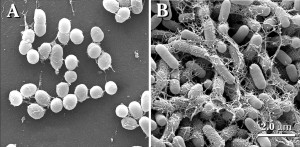The objectives of this study were to characterize the phenotype and genotype of 36 non-O157 Shiga toxin–producing Escherichia coli (STEC) strains isolated from humans, ovines, or bovines, including the top 6 (O26, O45, O103, O111, O121, and O145) and three other serogroups implicated in serious illness (O91, O113, and O128).
 Biofilms were formed by all strains with intermediate to strong biofilm producers (n = 24) more common at 22°C than at 37°C (p < 0.001) and 48 and 72 h (p < 0.001) than 24 h of incubation time. Biofilm-forming potential differed by serogroup and origin with O113 and human strains exhibiting the highest potential (p < 0.001). Biofilm-associated genes, csgA/csgD/crl/fimH (100%), flu (94%), rpoS (92%), ehaAα (89%), and cah (72%), were most prevalent, while mlrA (22%) and ehaAβ (14%) were least prevalent, although there was no clear compliment of genes associated with strains exhibiting the greatest biofilm-forming capacity.
Biofilms were formed by all strains with intermediate to strong biofilm producers (n = 24) more common at 22°C than at 37°C (p < 0.001) and 48 and 72 h (p < 0.001) than 24 h of incubation time. Biofilm-forming potential differed by serogroup and origin with O113 and human strains exhibiting the highest potential (p < 0.001). Biofilm-associated genes, csgA/csgD/crl/fimH (100%), flu (94%), rpoS (92%), ehaAα (89%), and cah (72%), were most prevalent, while mlrA (22%) and ehaAβ (14%) were least prevalent, although there was no clear compliment of genes associated with strains exhibiting the greatest biofilm-forming capacity.
Among 12 virulence genes screened, iha and ehxA were present in 92% of the strains. The occurrence of stx1 in the top 6 serogroups (8/12, 67%) did not differ (p = 0.8) from other serogroups (17/24, 71%), but stx2 was less likely (confidence interval [CI] = 0.14–1.12; p = 0.04) to be in the former (9/24, 38%) than the latter (9/12, 75%). Excluding serogroups, O91 and O121, at least one strain per serogroup was resistant to between three and six antimicrobials. Streptomycin (31%), sulfisoxazole (31%), and tetracycline (25%) resistance was most common and was 35–50% less likely (p < 0.05) in human than animal strains.
All non-O157 STEC strains were able to form biofilms on an abiotic surface, with some exhibiting resistance to multiple antimicrobials. Potential as a reservoir of antimicrobial resistance genes may be another hazard of biofilms in food-processing plants. As a result, future strategies to control these pathogens may include measures to prevent biofilms.
Biofilm formation, virulence gene profiles, and antimicrobial resistance of nine serogroups of non-O157 shiga toxin-producing E. coli
Wang, K. Stanford, T.A. McAllister, R.P. Johnson, J. Chen, H. Hou, G. Zhang, and Y.D. Niu
Foodborne Pathogens and Disease, Volume 13, Number 6, March 2016, Pages 1-9, DOI: 10.1089/fpd.2015.2099
http://online.liebertpub.com/doi/abs/10.1089/fpd.2015.2099
